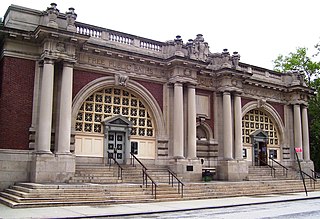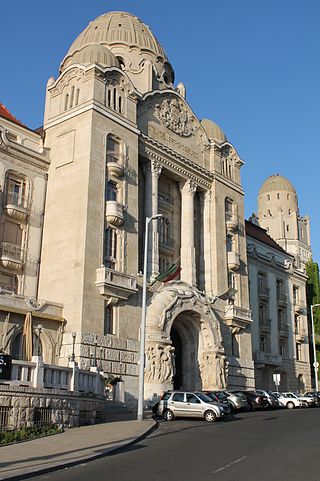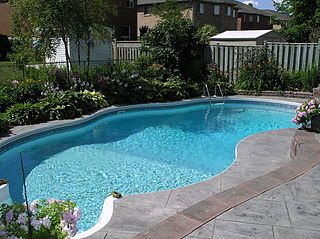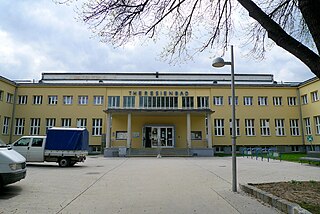
A sauna is a room or building designed as a place to experience dry or wet heat sessions, or an establishment with one or more of these facilities. The steam and high heat make the bathers perspire. A thermometer in a sauna is typically used to measure temperature; a hygrometer can be used to measure levels of humidity or steam. Infrared therapy is often referred to as a type of sauna, but according to the Finnish sauna organizations, infrared is not a sauna.

In ancient Rome, thermae and balneae were facilities for bathing. Thermae usually refers to the large imperial bath complexes, while balneae were smaller-scale facilities, public or private, that existed in great numbers throughout Rome.

Thermae Bath Spa is a combination of the historic spa and a contemporary building in the city of Bath, England, and reopened in 2006. Bath and North East Somerset council own the buildings, and, as decreed in a Royal Charter of 1590, are the guardians of the spring waters, which are the only naturally hot, mineral-rich waters in the UK. The Spa is operated by YTL Hotels.

Public baths originated when most people in population centers did not have access to private bathing facilities. Though termed "public", they have often been restricted according to gender, religious affiliation, personal membership, and other criteria.

A spa is a location where mineral-rich spring water is used to give medicinal baths. Spa towns or spa resorts typically offer various health treatments, which are also known as balneotherapy. The belief in the curative powers of mineral waters goes back to prehistoric times. Such practices have been popular worldwide, but are especially widespread in Europe and Japan. Day spas and medspas are also quite popular, and offer various personal care treatments.

The Gellért Thermal Bath, also known as the Gellért Baths, is a bath complex in Budapest in Hungary. It is part of the famous Hotel Gellért in Buda.

The Széchenyi Medicinal Bath in Budapest is the largest medicinal bath in Europe. Its water is supplied by two thermal springs, their temperature is 74 °C (165 °F) and 77 °C (171 °F).

A frigidarium is one of the three main bath chambers of a Roman bath or thermae, namely the cold room. It often contains a swimming pool.

Rudas Bath or Rudas fürdő is a thermal bath in Budapest, Hungary which is claimed to have medicinal properties. It was founded in 1571/1572 during the time of Ottoman rule. To date, it retains many of the key elements of a Hammam, exemplified by its Ottoman dome and octagonal pool. It is located at Döbrentei tér 9 on the Buda side of Erzsébet Bridge. The bath has six therapy pools and one swimming pool where the temperature is in between 10 and 42 °C. The components of slightly radioactive thermal water includes sulfate, calcium, magnesium, bicarbonate and a significant amount of fluoride ion. A sight-seeing brochure claims the water can help to treat degenerative joint illnesses, chronic and sub-acute joint inflammations, vertebral disk problems, neuralgia and lack of calcium in the bone system.
The Tollygunge Club, popularly called Tolly Club, is a country club in India, located in Tollygunge in south Kolkata.

The Adelaide Aquatic Centre is a complex of indoor heated swimming pools operated by the Adelaide City Council and located in the northernmost extent of the Adelaide Parklands in North Adelaide, Australia. It is located in the square of parkland bordered by Jeffcott Street, Barton Terrace West, Prospect Road and Fitzroy Terrace. There is a car park to the west whose entrance is off Jeffcott Street, but the entrance to the centre itself faces north, towards Fitzroy Terrace. The centre opened on 20 December 1969.

A swimming pool, swimming bath, wading pool, paddling pool, or simply pool, is a structure designed to hold water to enable swimming or other leisure activities. Pools can be built into the ground or built above ground, and may be found as a feature aboard ocean-liners and cruise ships. In-ground pools are most commonly constructed from materials such as concrete, natural stone, metal, plastic, composite or fiberglass, and can be of a custom size and shape or built to a standardized size, the largest of which is the Olympic-size swimming pool.

The Theresienbad is a complex of indoor and outdoor swimming pools in the Meidling district of urban Vienna.

Oasis Sports Centre is a leisure centre in Holborn, London, operated by Better on behalf of the London Borough of Camden.

Therme Erding is the largest thermal bath complex in Europe. It is 30 minutes northeast of Munich by car and is visited by around 5000 people every day.

The Lukács Thermal Bath is a historic indoor/outdoor thermal bath spa in Budapest, Hungary, heated by natural hot springs. All pools and four saunas can be used by all guests except for the optional area of the sauna world, which contains five more saunas, ice cooling pool, igloo and heated roman bench.
Thermal baths or spas in Budapest are popular tourist attractions as well as public comforts for the city's residents.

Spanien Public Baths, colloquially known simply as Spanien, is a public bath house and a listed building in Aarhus, Denmark. The bath house was completed in 1931 and was listed on the Danish national registry of protected buildings and places by the Danish Heritage Agency on 15 February 1989 as a fine example of the Nordic funkis style. The building was thoroughly renovated in 2010–12.

Miramar is a water park, salt-water spa and sauna complex opened in 1973 at the Waidsee Lake, Weinheim, Germany. As of 2014, approximately 50% of the 650,000 annual visitors pay extra for the Sauna area. The catchment area for visitors covers a 100 kilometres (60 mi) radius, including Frankfurt am Main to the north, and Pforzheim to the south.






























